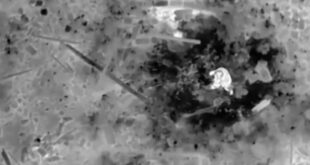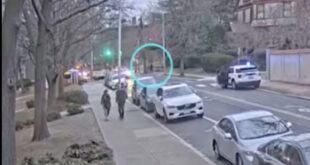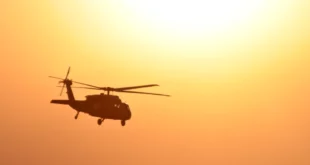“We know we are risking our lives,” one partisan said. “But the mission is worth the risk.”
by Susan Katz Keating
As Vladimir Putin is set to remain in charge at the Kremlin for another six years, a secretive resistance group is trolling Moscow and showing partisans where to destroy key Russian targets. The group, “Atesh,” specializes in sabotage and reconnaissance, and in taunting Moscow with photos to show how deeply it has penetrated Russian territory.
“We are Fire,” one guerrilla told Soldier of Fortune on a secure messaging ap. “That is our name” in Crimean Tatar. “Fire is who we are.”
Since it was founded in 2022, the group has claimed a series of strikes against people, buildings, and equipment. Atesh says it has ambushed and killed Russian soldiers, set barracks on fire, and bombed government offices.
“Some of our people do sabotage,” said the guerrilla, who calls himself Yuri. “Others are spies, and some are instructors.”
READ MORE: Of Saboteurs and Secrecy: An Underground Resistance Takes Shape Inside Russia
The movement is led by Crimean Tatars who mostly are based on the occupied peninsula, Yuri said. Members include Ukrainians and active duty Russian soldiers who undermine their own army, he said.
With no clear public leader, the group has gained notice from the 80-year-old godfather of the Crimean Tatar rights movement, Mustafa Dzhemilev.
“Atesh is very deep underground,” Dzhemilev told the Guardian newspaper last year. A partisan himself during the Soviet era, Dzhemilev praised the modern guerrillas for their clean getaways and high operational tempo. “There was not a single arrest among Atesh members, but they are working inside Crimea territory blowing up targets,” he said.
Pro-Russian critics in Eastern Europe have cast Atesh as a public relations stunt with little to back up its claims. But the partisan group also is illegal inside Russia, lending credence to the notion that the Kremlin views it as threatening.
The Kremlin did not immediately respond to a request for comment.
Atesh emerged from a fusion between peoples, noted one independent journalist who focuses on military history in the region.
“Ukrainians and Crimean Tatars, two groups with rich historical tapestries interwoven with tales of resistance and survival, found common cause in the face of the Russian military invasion,” according to writer Bogdan Maftei. “This union was more than strategic; it was a fusion of shared suffering and a mutual desire to protect their homeland.”
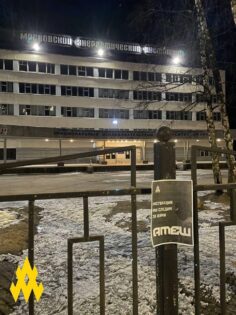
Atesh poster in Moscow.
Early in its formative days, the group focused on gathering intelligence.
“This task was not just about collecting data; it was about understanding the enemy,” Maftei said. The partisans went directly inside the Russian military. “They tapped into a unique source – disgruntled naval servicemen, whose dissatisfaction with their pay and conditions made them a fount of inside information.”
Members now actively troll the Moscow government, posting flyers asking people to join the resistance.
In the days leading up to the Russian presidential election in March, Atesh agents stepped up their efforts.
“Our activists distributed leaflets calling on them to ignore the so-called ‘elections,’ ” organizers wrote on a secure messaging channel. The leaflets appeared in shopping malls, on gates and on lamp posts, and elsewhere throughout Russia.
In a group messaging thread, Atesh guerrillas identified specific targets and how to hit them.
“Agents of our movement infiltrated a missile weapons warehouse near the Belbek airfield” in Sevastopol, the activists wrote. “According to our information, this is where R-73, R-27, R-37 missiles and other weapons are stored, which are used to strike civilian cities in Ukraine.”
The activists gave coordinates for saboteurs to use when targeting the warehouse; and also identified what they said were Russian decoy sites.
“We noticed that the Russians have set up fake warehouses to deceive the Ukrainian Defense Forces,” the activists wrote. “However, we are aware of them and all information has been passed on to the appropriate people.”
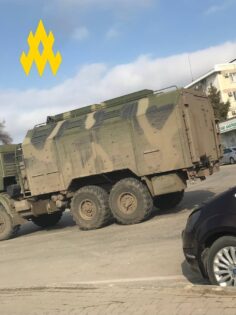
Atesh reconnaissance photo
A primary target now is the 12-mile Kerch Bridge connecting Crimea to Russia, Yuri told Soldier of Fortune.
The bridge is valuable on many levels, he said, and is an object of particular pride for Putin. Atesh agents have reconnoitered the bridge and studied its conditions, he said.
The guerrilla group already has caused problems for the Black Sea Fleet operating near the bridge, Atesh agents wrote on their messaging channel.
“But we believe that this object should not exist,” they told their followers. “Together with you, we can completely destroy it.”
Aside from reconnaissance and demolition, a major aspect of the group’s operations has been to teach Russian soldiers to sabotage their own equipment, Yuri said. The group started a sabotage school, and last year said it had enrolled 4,000 Russian soldiers.
Those numbers could not be independently verified, and a website listed for the school is not active.
The website may have been compromised, Yuri said, without giving specifics. But, he added, Atesh does not need a formal school for sabotage.
“These methods are taught in person,” Yuri said.
The partisans continue to focus on specific targets, he said. Among them is a site used by the Russian military in Perevalnoye.
“Our agents established that there are a large number of personnel near the military unit,” activists wrote on their secure messaging channel.
The activists described the unit and its locale in detail.
“On the side of the military camp there is a checkpoint, there is a duty shift of two people, reinforced by a police squad,” the activists wrote. “Military police patrol along the fence of the military unit.”
The Russians keep 15 KAMAZ trucks not far from the main checkpoint, and the personnel live in rented housing in Perevalnoye itself, the group reported.

With so much detail and so many photographs being posted on the channel, how likely is it that the prolific agents will be discovered?
“There is a chance this can happen,” Yuri told Soldier of Fortune. “This goes with the territory. We know we are risking our lives. But our mission is worth the risk.”
Atesh is determined to press on, Yuri said.
“We will keep hitting the orcs,” he said, using a slang term for the Russian military. “They are the swamp horde. We are fire.”
Susan Katz Keating is the publisher and editor in chief at Soldier of Fortune.
 Soldier of Fortune Magazine The Journal of Professional Adventurers
Soldier of Fortune Magazine The Journal of Professional Adventurers




